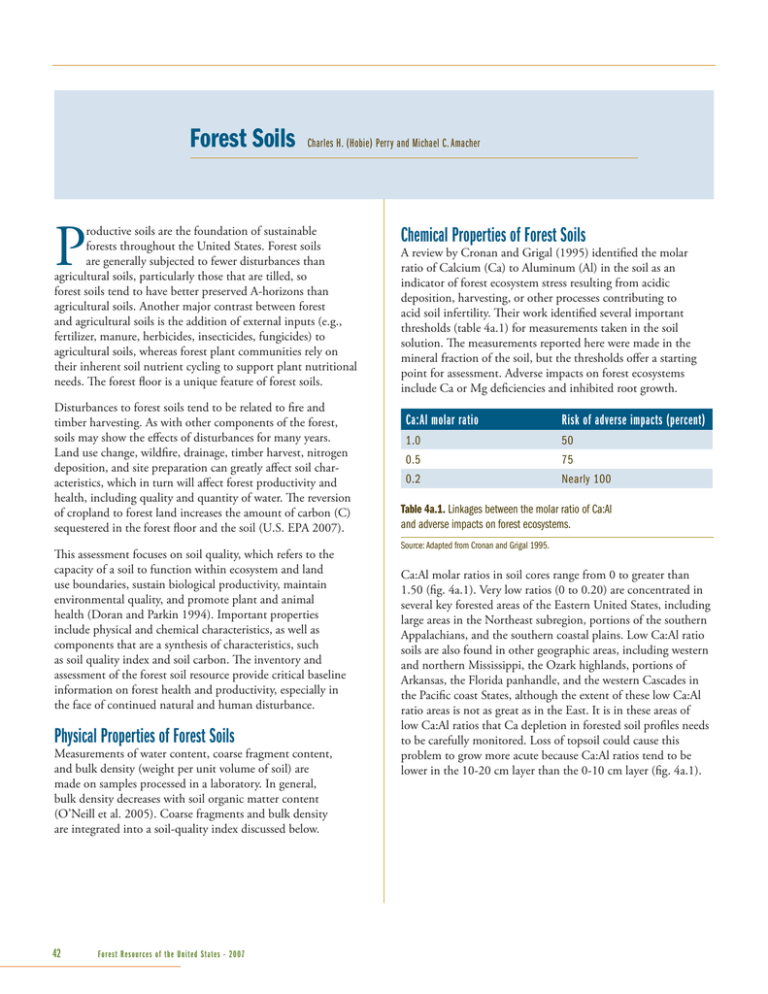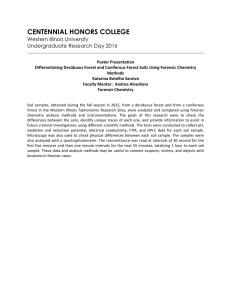P Chemical Properties of Forest Soils
advertisement

Forest Soils Charles H. (Hobie) Perry and Michael C. Amacher P roductive soils are the foundation of sustainable forests throughout the United States. Forest soils are generally subjected to fewer disturbances than agricultural soils, particularly those that are tilled, so forest soils tend to have better preserved A-horizons than agricultural soils. Another major contrast between forest and agricultural soils is the addition of external inputs (e.g., fertilizer, manure, herbicides, insecticides, fungicides) to agricultural soils, whereas forest plant communities rely on their inherent soil nutrient cycling to support plant nutritional needs. The forest floor is a unique feature of forest soils. Disturbances to forest soils tend to be related to fire and timber harvesting. As with other components of the forest, soils may show the effects of disturbances for many years. Land use change, wildfire, drainage, timber harvest, nitrogen deposition, and site preparation can greatly affect soil characteristics, which in turn will affect forest productivity and health, including quality and quantity of water. The reversion of cropland to forest land increases the amount of carbon (C) sequestered in the forest floor and the soil (U.S. EPA 2007). This assessment focuses on soil quality, which refers to the capacity of a soil to function within ecosystem and land use boundaries, sustain biological productivity, maintain environmental quality, and promote plant and animal health (Doran and Parkin 1994). Important properties include physical and chemical characteristics, as well as components that are a synthesis of characteristics, such as soil quality index and soil carbon. The inventory and assessment of the forest soil resource provide critical baseline information on forest health and productivity, especially in the face of continued natural and human disturbance. Physical Properties of Forest Soils Measurements of water content, coarse fragment content, and bulk density (weight per unit volume of soil) are made on samples processed in a laboratory. In general, bulk density decreases with soil organic matter content (O’Neill et al. 2005). Coarse fragments and bulk density are integrated into a soil-quality index discussed below. 42 Forest Resources of the United States - 2007 Chemical Properties of Forest Soils A review by Cronan and Grigal (1995) identified the molar ratio of Calcium (Ca) to Aluminum (Al) in the soil as an indicator of forest ecosystem stress resulting from acidic deposition, harvesting, or other processes contributing to acid soil infertility. Their work identified several important thresholds (table 4a.1) for measurements taken in the soil solution. The measurements reported here were made in the mineral fraction of the soil, but the thresholds offer a starting point for assessment. Adverse impacts on forest ecosystems include Ca or Mg deficiencies and inhibited root growth. Ca:Al molar ratio Risk of adverse impacts (percent) 1.0 50 0.5 75 0.2 Nearly 100 Table 4a.1. Linkages between the molar ratio of Ca:Al and adverse impacts on forest ecosystems. Source: Adapted from Cronan and Grigal 1995. Ca:Al molar ratios in soil cores range from 0 to greater than 1.50 (fig. 4a.1). Very low ratios (0 to 0.20) are concentrated in several key forested areas of the Eastern United States, including large areas in the Northeast subregion, portions of the southern Appalachians, and the southern coastal plains. Low Ca:Al ratio soils are also found in other geographic areas, including western and northern Mississippi, the Ozark highlands, portions of Arkansas, the Florida panhandle, and the western Cascades in the Pacific coast States, although the extent of these low Ca:Al ratio areas is not as great as in the East. It is in these areas of low Ca:Al ratios that Ca depletion in forested soil profiles needs to be carefully monitored. Loss of topsoil could cause this problem to grow more acute because Ca:Al ratios tend to be lower in the 10-20 cm layer than the 0-10 cm layer (fig. 4a.1). 4 5 6 7 8 9 4 5 6 7 NE NE 0−10 cm 10−20 cm 8 9 10000 10000 1000 1000 100 100 10 10 1 1 0.1 0.1 NC NC 0−10 cm 10−20 cm 10000 10000 1000 1000 100 100 10 10 1 1 Figure 4a.1. Spatial distribution of Ca:Al ratios for 0-10 and 10-20 cm. Further insight into Ca:Al ratios in forest soils can be gained by examining the effect of soil pH on exchangeable Ca and Al (fig. 4a.2). In general, as soil pH decreases, exchangeable Ca also decreases and exchangeable Al increases. The highest exchangeable Al, lowest exchangeable Ca, and lowest pH soils are found in the Northeast subregion and South region (fig. 4a.2; see also appendix C, table 50). Because of Al solubility relationships in soils, exchangeable Al is generally detrimental to plants only when the soil pH is below 5.2; western soils—having naturally higher pH—are less likely to exhibit problems. High soil organic matter levels can also ameliorate potentially toxic levels of Al by complexing (binding or sequestering) excess Al. Element concentration, mg/kg soil 0.1 0.1 SO SO 0−10 cm 10−20 cm 10000 10000 1000 1000 100 100 10 10 1 1 0.1 0.1 IW IW 0−10 cm 10−20 cm 10000 10000 1000 1000 100 100 10 10 1 1 0.1 0.1 PW PW 0−10 cm 10−20 cm 10000 10000 1000 1000 100 100 10 10 1 1 0.1 0.1 4 5 6 7 8 9 4 5 6 7 8 9 Soil pH in Water Calcium Aluminum Figure 4a.2. Relationship between exchangeable Ca or Al and soil pH by Forest Inventory and Analysis region. Forest Productivity and Health 43 Soil Quality Index Soil Carbon To facilitate data analysis and interpretation, we integrated 19 physical and chemical soil properties into a soil quality index (SQI) that can be used as an overall measure of soil quality (Amacher et al. 2007). Lower SQI numbers (< 50) within a given area indicate the potential for an increased risk of soil-related forest health decline. Because of increased soil weathering (high rainfall and temperatures), soils in the Southeast subregion tend to have lower SQI values than the relatively unweathered soils of the West (fig. 4a.3). The 10-20 cm layer tends to have lower SQI values than the 0-10 cm layer because of lower soil pH, lower organic C, lower nutrient levels, and higher bulk densities. Although forest plant species in regions with lower SQI levels tend to be more adapted to those soil conditions, they may also be susceptible to increased risk of decline with added environmental stressors (e.g., increase in Ca depletion). Soil carbon is significant for several reasons. First, carbon is the primary component of soil organic matter, which has a number of important functions. These functions include increasing water-holding capacity, retaining some nutrients by cation exchange (e.g., Ca2+, Mg2+, K+), releasing other nutrients as organic matter decays (e.g., N, P, and S), and capturing potential toxic agents (e.g., Hg) (McBride 1994). Nationally and internationally, carbon is also inventoried to track the sequestration of certain greenhouse gases. Although the Forest Inventory and Analysis program samples both mineral and organic soils, we do not report on organic soils here because of our inability to calculate bulk density on these samples. Carbon stocks in the soil are strongly influenced by the addition and decomposition of organic matter. Carbon stocks are generally greater at higher latitudes and elevations. In general, the northern tier of the United States has greater carbon stocks than the Southern United States, although a distinct area of higher carbon storage extends from north to south in both the Appalachian and Rocky Mountains, as well as the Cascades and Sierras (fig. 4a.4). Figure 4a.3. Spatial distribution of the soil quality index by soil layer. Figure 4a.4. Spatial distribution of soil carbon by sample location. 44 Forest Resources of the United States - 2007






